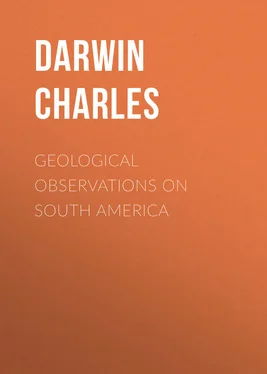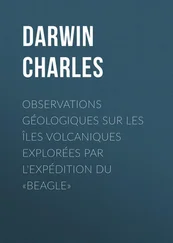Charles Darwin - Geological Observations on South America
Здесь есть возможность читать онлайн «Charles Darwin - Geological Observations on South America» — ознакомительный отрывок электронной книги совершенно бесплатно, а после прочтения отрывка купить полную версию. В некоторых случаях можно слушать аудио, скачать через торрент в формате fb2 и присутствует краткое содержание. Жанр: foreign_antique, foreign_prose, на английском языке. Описание произведения, (предисловие) а так же отзывы посетителей доступны на портале библиотеки ЛибКат.
- Название:Geological Observations on South America
- Автор:
- Жанр:
- Год:неизвестен
- ISBN:нет данных
- Рейтинг книги:3 / 5. Голосов: 1
-
Избранное:Добавить в избранное
- Отзывы:
-
Ваша оценка:
- 60
- 1
- 2
- 3
- 4
- 5
Geological Observations on South America: краткое содержание, описание и аннотация
Предлагаем к чтению аннотацию, описание, краткое содержание или предисловие (зависит от того, что написал сам автор книги «Geological Observations on South America»). Если вы не нашли необходимую информацию о книге — напишите в комментариях, мы постараемся отыскать её.
Geological Observations on South America — читать онлайн ознакомительный отрывок
Ниже представлен текст книги, разбитый по страницам. Система сохранения места последней прочитанной страницы, позволяет с удобством читать онлайн бесплатно книгу «Geological Observations on South America», без необходимости каждый раз заново искать на чём Вы остановились. Поставьте закладку, и сможете в любой момент перейти на страницу, на которой закончили чтение.
Интервал:
Закладка:
If the above remarks be just, we are led to the very unexpected conclusion, that a dry climate, by leaving the salt from the sea-spray undissolved, is much less favourable to the preservation of upraised shells than a humid climate. However this may be, it is interesting to know the manner in which masses of shells, gradually upraised above the sea-level, decay and finally disappear.
SUMMARY ON THE RECENT ELEVATION OF THE WEST COAST OF SOUTH AMERICA.
We have seen that upraised marine remains occur at intervals, and in some parts almost continuously, from latitude 45 degrees 35' to 12 degrees S., along the shores of the Pacific. This is a distance, in a north and south line, of 2,075 geographical miles. From Byron's observations, the elevation has no doubt extended sixty miles further south; and from the similarity in the form of the country near Lima, it has probably extended many leagues further north. (I may take this opportunity of stating that in a MS. in the Geological Society by Mr. Weaver, it is stated that beds of oysters and other recent shells are found thirty feet above the level of the sea, in many parts of Tampico, in the Gulf of Mexico.) Along this great line of coast, besides the organic remains, there are in very many parts, marks of erosion, caves, ancient beaches, sand-dunes, and successive terraces of gravel, all above the present level of the sea. From the steepness of the land on this side of the continent, shells have rarely been found at greater distances inland than from two to three leagues; but the marks of sea-action are evident farther from the coast; for instance, in the valley of Guasco, at a distance of between thirty and forty miles. Judging from the upraised shells alone, the elevation in Chiloe has been 350 feet, at Concepcion certainly 625 feet; and by estimation 1,000 feet; at Valparaiso 1,300 feet; at Coquimbo 252 feet; northward of this place, sea-shells have not, I believe, been found above 300 feet; and at Lima they were falling into decay (hastened probably by the salt) at 85 feet. Not only has this amount of elevation taken place within the period of existing Mollusca and Cirripedes; but their proportional numbers in the neighbouring sea have in most cases remained the same. Near Lima, however, a small change in this respect between the living and the upraised was observed: at Coquimbo this was more evident, all the shells being existing species, but with those embedded in the uppermost calcareous plain not approximating so closely in proportional numbers, as do those that lie loose on its surface at the height of 252 feet, and still less closely than those which are strewed on the lower plains, which latter are identical in proportional numbers with those now cast up on the beach. From this circumstance, and from not finding, upon careful examination, near Coquimbo any shells at a greater height than 252 feet, I believe that the recent elevation there has been much less than at Valparaiso, where it has been 1,300 feet, and I may add, than at Concepcion. This considerable inequality in the amount of elevation at Coquimbo and Valparaiso, places only 200 miles apart, is not improbable, considering, first, the difference in the force and number of the shocks now yearly affecting different parts of this coast; and, secondly, the fact of single areas, such as that of the province of Concepcion, having been uplifted very unequally during the same earthquake. It would, in most cases, be very hazardous to infer an inequality of elevation, from shells being found on the surface or in superficial beds at different heights; for we do not know on what their rate of decay depends; and at Coquimbo one instance out of many has been given, of a promontory, which, from the occurrence of one very small collection of lime-cemented shells, has indisputably been elevated 242 feet, and yet on which, not even a fragment of shell could be found on careful examination between this height and the beach, although many sites appeared very favourable for the preservation of organic remains: the absence, also, of shells on the gravel-terraces a short distance up the valley of Coquimbo, though abundant on the corresponding terraces at its mouth, should be borne in mind.
There are other epochs, besides that of the existence of recent Mollusca, by which to judge of the changes of level on this coast. At Lima, as we have just seen, the elevation has been at least eighty-five feet, within the Indo-human period; and since the arrival of the Spaniards in 1530, there has apparently been a sinking of the surface. At Valparaiso, in the course of 220 years, the rise must have been less than nineteen feet; but it has been as much as from ten to eleven feet in the seventeen years subsequently to 1817, and of this rise only a part can be attributed to the earthquake of 1822, the remainder having been insensible and apparently still, in 1834, in progress. At Chiloe the elevation has been gradual, and about four feet during four years. At Coquimbo, also, it has been gradual, and in the course of 150 years has amounted to several feet. The sudden small upheavals, accompanied by earthquakes, as in 1822 at Valparaiso, in 1835 at Concepcion, and in 1837 in the Chonos Archipelago, are familiar to most geologists, but the gradual rising of the coast of Chile has been hardly noticed; it is, however, very important, as connecting together these two orders of events.
The rise of Lima, having been eighty-five feet within the period of man, is the more surprising if we refer to the eastern coast of the continent, for at Port S. Julian, in Patagonia, there is good evidence (as we shall hereafter see) that when the land stood ninety feet lower, the Macrauchenia, a mammiferous beast, was alive; and at Bahia Blanca, when it stood only a few feet lower than it now does, many gigantic quadrupeds ranged over the adjoining country. But the coast of Patagonia is some way distant from the Cordillera, and the movement at Bahia Blanca is perhaps noways connected with this great range, but rather with the tertiary volcanic rocks of Banda Oriental, and therefore the elevation at these places may have been infinitely slower than on the coast of Peru. All such speculations, however, must be vague, for as we know with certainty that the elevation of the whole coast of Patagonia has been interrupted by many and long pauses, who will pretend to say that, in such cases, many and long periods of subsidence may not also have been intercalated?
In many parts of the coast of Chile and Peru there are marks of the action of the sea at successive heights on the land, showing that the elevation has been interrupted by periods of comparative rest in the upward movement, and of denudation in the action of the sea. These are plainest at Chiloe, where, in a height of about five hundred feet, there are three escarpments, – at Coquimbo, where in a height of 364 feet, there are five, – at Guasco, where there are six, of which five may perhaps correspond with those at Coquimbo, but if so, the subsequent and intervening elevatory movements have been here much more energetic, – at Lima, where, in a height of about 250 feet there are three terraces, and others, as it is asserted, at considerably greater heights. The almost entire absence of ancient marks of sea-action at defined levels along considerable spaces of coast, as near Valparaiso and Concepcion, is highly instructive, for as it is improbable that the elevation at these places alone should have been continuous, we must attribute the absence of such marks to the nature and form of the coast-rocks. Seeing over how many hundred miles of the coast of Patagonia, and on how many places on the shores of the Pacific, the elevatory process has been interrupted by periods of comparative rest, we may conclude, conjointly with the evidence drawn from other quarters of the world, that the elevation of the land is generally an intermittent action. From the quantity of matter removed in the formation of the escarpments, especially of those of Patagonia, it appears that the periods of rest in the movement, and of denudation of the land, have generally been very long. In Patagonia, we have seen that the elevation has been equable, and the periods of denudation synchronous over very wide spaces of coast; on the shores of the Pacific, owing to the terraces chiefly occurring in the valleys, we have not equal means of judging on this point; and the very different heights of the upraised shells at Coquimbo, Valparaiso, and Concepcion seem directly opposed to such a conclusion.
Читать дальшеИнтервал:
Закладка:
Похожие книги на «Geological Observations on South America»
Представляем Вашему вниманию похожие книги на «Geological Observations on South America» списком для выбора. Мы отобрали схожую по названию и смыслу литературу в надежде предоставить читателям больше вариантов отыскать новые, интересные, ещё непрочитанные произведения.
Обсуждение, отзывы о книге «Geological Observations on South America» и просто собственные мнения читателей. Оставьте ваши комментарии, напишите, что Вы думаете о произведении, его смысле или главных героях. Укажите что конкретно понравилось, а что нет, и почему Вы так считаете.












